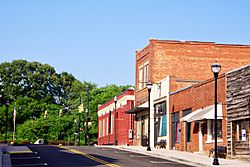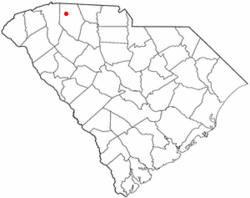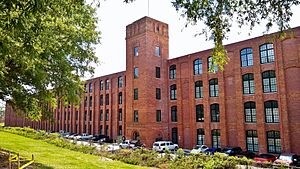Inman, South Carolina facts for kids
Quick facts for kids
Inman, South Carolina
|
|||
|---|---|---|---|

Businesses along Mill Street
|
|||
|
|||

Location of Inman, South Carolina
|
|||
| Country | United States | ||
| State | South Carolina | ||
| County | Spartanburg | ||
| Founded | December 22, 1882 | ||
| Area | |||
| • Total | 1.73 sq mi (4.49 km2) | ||
| • Land | 1.73 sq mi (4.48 km2) | ||
| • Water | 0.00 sq mi (0.01 km2) | ||
| Elevation | 981 ft (299 m) | ||
| Population
(2020)
|
|||
| • Total | 2,990 | ||
| • Density | 1,728.32/sq mi (667.24/km2) | ||
| Time zone | UTC-5 (Eastern (EST)) | ||
| • Summer (DST) | UTC-4 (EDT) | ||
| ZIP code |
29349
|
||
| Area codes | 864, 821 | ||
| FIPS code | 45-35755 | ||
| GNIS feature ID | 1223455 | ||
| Website | www.cityofinman.org | ||
Inman is a city in Spartanburg County, South Carolina, United States. It is part of the larger Spartanburg area. In 2020, about 2,990 people lived here.
Inman is a great place for outdoor fun. You can visit nearby Lake Bowen for water sports and fishing. The city is also easy to reach by major highways like Interstate 26 and Interstate 85. Inman has a historic main street, many churches, and its own school district.
Contents
History of Inman
Inman became an official town in South Carolina on December 22, 1882. It grew up where two old roads, Howard Gap and Blackstock, met. A local landowner named William Gowan helped start the town. He offered to build a train station, which convinced the railroad to make a stop there.
Some historians say the town was named after the railroad president or a surveyor. However, a geographer named Henry Gannett said it was named after a local person. Soon, small businesses like a blacksmith, a bank, and a barber shop opened near the train station. In the 1930s, Inman was known as the "fresh peach capital of the world." Two historic buildings, the Bush House and Shiloh Methodist Church, are listed on the National Register of Historic Places. This means they are important historical sites.
In 1901, James A. Chapman started Inman Mills. This company still makes fabric today. The mill was a big employer in the city for many years. The original mill building closed in 2001. It was also added to the National Register of Historic Places in 2016. Now, the old mill building has been turned into apartments.
In 1935, a local man named Bryson Hammet found a large stone. It was near South Carolina Highway 292. The stone had different marks and the year 1567 carved into it. For many years, historians have wondered if the stone is real and what it means. Many believe it was left by a Spanish explorer and gold seeker named Captain Juan Pardo.
Geography and Climate
Inman is located at 35°2′51″N 82°5′25″W / 35.04750°N 82.09028°W. It is just north of Spartanburg. It is also a few miles south of the North Carolina-South Carolina border.
The city's historic area is along South Carolina Highway 292. This road is just north of where it meets U.S. Route 176. Highway 292 also connects Inman to Interstate 26 to the east. The community of Inman Mills is right next to Inman, to the southwest.
The United States Census Bureau says that Inman covers about 0.9 square miles (2.3 square kilometers). All of this area is land.
Inman's Climate
Inman is in the "Upstate" region of South Carolina. The weather here is mild all year. This is because of something called the Isothermal Belt. This happens when warmer air from the western side of the Appalachian Mountains blows over the mountains. This creates a wide area where temperatures can change a lot, sometimes by 20 degrees Fahrenheit or more.
Population Facts
| Historical population | |||
|---|---|---|---|
| Census | Pop. | %± | |
| 1890 | 134 | — | |
| 1900 | 294 | 119.4% | |
| 1910 | 474 | 61.2% | |
| 1920 | 694 | 46.4% | |
| 1930 | 969 | 39.6% | |
| 1940 | 1,115 | 15.1% | |
| 1950 | 1,514 | 35.8% | |
| 1960 | 1,714 | 13.2% | |
| 1970 | 1,661 | −3.1% | |
| 1980 | 1,554 | −6.4% | |
| 1990 | 1,742 | 12.1% | |
| 2000 | 1,884 | 8.2% | |
| 2010 | 2,321 | 23.2% | |
| 2020 | 2,990 | 28.8% | |
| U.S. Decennial Census | |||
2020 Census Information
| Race | Num. | Perc. |
|---|---|---|
| White (non-Hispanic) | 2,081 | 69.6% |
| Black or African American (non-Hispanic) | 488 | 16.32% |
| Native American | 5 | 0.17% |
| Asian | 122 | 4.08% |
| Other/Mixed | 138 | 4.62% |
| Hispanic or Latino | 156 | 5.22% |
The 2020 United States census counted 2,990 people living in Inman. There were 1,141 households and 604 families. The average income for a household was $51,210. The average value of a home was $106,000. About 62% of people owned their homes. Most people drove alone to work. Their average commute time was about 20.5 minutes. Households in Inman owned about two cars on average.
Education in Inman
Students in Inman attend several local schools. These include Inman Elementary, Inman Intermediate, and Mabry Middle School. Older students go to Chapman High School. Inman also has a lending library. It is a part of the Spartanburg County Public Library system.
Famous People from Inman
- Fieldin Culbreth, an umpire in Major League Baseball (MLB)
- Heath Hembree, a pitcher in Major League Baseball (MLB)
- James Hylton, a NASCAR race car driver
- Deebo Samuel, a wide receiver in the National Football League (NFL)
See also
 In Spanish: Inman (Carolina del Sur) para niños
In Spanish: Inman (Carolina del Sur) para niños




